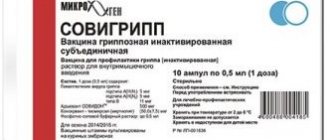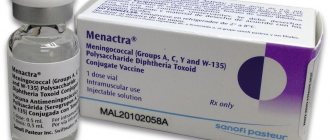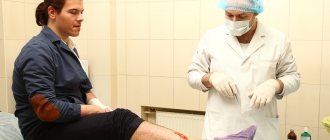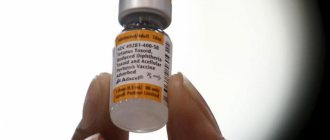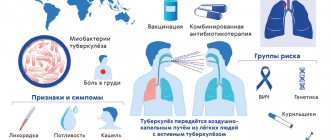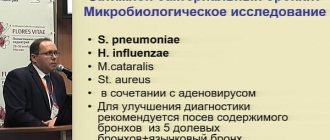“Pentaxim” is a vaccine that is given to children in the form of injections (shots) to prevent a number of dangerous infectious diseases:
- polio;
- diphtheria;
- whooping cough;
- meningitis;
- tetanus;
- septicemia.
Vaccinations are given to children at least 3 months of age, often during the first year of life, up to a maximum of 48 months (4 years) inclusive. The last suitable date for vaccination is 47 months and 29 days. If there has been no vaccination before 12 months, Pentaxim is administered only in the form of a suspension.
What diseases does Pentaxim protect against?
- Diphtheria is a severe bacterial infection that affects the mucous membranes of the nose and throat. The mortality rate from diphtheria, even in modern conditions, exceeds 10%.
- Whooping cough is a very dangerous disease for children under two years of age, and the mortality rate from it is also very high. At the same time, whooping cough is very contagious (even casual contact with a patient leads to infection in 100% of cases) and is relatively common.
- Tetanus is a serious infection that kills about 100,000 people worldwide every year. In countries where mass vaccination is carried out, the incidence of tetanus is 100 times lower.
- Poliomyelitis is infantile spinal paralysis, a disease that is currently rare, but highly contagious (very contagious).
- Haemophilus influenzae type B is the causative agent of 25% of pneumonia and sepsis, half of severe meningitis and 80% of epiglottitis in children under 5 years of age. This is why it is so important to vaccinate your child against this infection on time.
Vaccination for the whole family! About the vaccinations that adults and children need
Description of the drug
The Pentaxim vaccine is one of the most modern combined vaccines, which allows you to simultaneously protect a child from five dangerous infections. Pentaxim belongs to a new generation of acellular (cell-free) vaccines that replaced cellular (cellular) vaccines. Acellular vaccines are less reactogenic because are devoid of bacterial membrane lipopolysaccharides that cause reactions after vaccination. Pentaxim is a highly immunogenic vaccine, i.e. giving a high immune response of the body after vaccination.
Pentaxim is a combination vaccine containing adsorbed acellular pertussis-diphtheria-tetanus vaccine, inactivated polio vaccine and a vaccine for the prevention of Haemophilus influenzae type b. This allows one injection to immunize a child against whooping cough, diphtheria, tetanus, polio and diseases caused by Haemophilus influenzae (meningitis, sepsis, pneumonia, epiglottitis, etc.).
The presence of five components in one vaccine allows you to minimize the number of injections, thereby significantly reducing pain in the child.
At what age is it better to get the Pentaxim vaccine? How long does it take to do the second Pentax?
The Pentaxim vaccination schedule is as follows: according to the National Vaccination Calendar, it is carried out at 3 months, then at 4.5, then at 6 months. This is followed by revaccination one year after the third administration (approximately one and a half years).
- If the first vaccination took place after 6 months, then for the third vaccination and subsequent revaccination, when diluting Pentaxim, no component is added that protects against Haemophilus influenzae infection.
- If the first vaccination took place after 12 months, this component is not added for the second and all subsequent administrations.
Find out more about the vaccination calendar
"Pentaxim": instructions
Vaccination is carried out in a clinical setting. The injection is given only intramuscularly - it cannot be administered subcutaneously or intravenously. A single dosage of the working solution is 0.5 ml. Vaccinations are placed in the middle third of the femoral surface. It is important to ensure that the needle enters the muscle tissue and not the blood vessels.
When using a package with 2 needles, the doctor secures the needle tightly by turning it a quarter circle. To prepare the vaccine, remove the plastic cap from the bottle, draw the suspension into a syringe and, without removing it, shake the bottle until the mass is completely dissolved. As a result, a white suspension is formed. The finished vaccine is not stored - it must be administered immediately after preparation.
Dosing interval:
- The first vaccine is administered after the child reaches 3 months of age.
- The second dose is given after 30-60 days.
- The third dose is given at the same interval.
In some cases, the schedule is violated, but in any case, the interval between the administration of 2 and 3 doses remains the same. The booster vaccination is given after 12 months.
In case of vaccination of children aged 6-12 months, the interval between vaccinations is 6 weeks. Moreover, for revaccination, Pentaxim is used in the usual dosage, but when it is diluted, conjugated tetanus toxoid is added.
Compatibility and revaccination
- Is it possible to do Pentaxim after DTP? Is it possible to do regular DTP after Pentaxim?
The answer to both questions is yes, you can. If you only have DTP at your disposal, it is better not to wait for an imported vaccine to appear, but to get vaccinated on time. Discuss your polio and hemophilus influenzae vaccination schedule with your pediatrician, as these components are not included in the DPT vaccine.
- Is it possible to do Infanrix Hexa after Pentaxim?
The Infanrix Hexa vaccine can replace Pentaxim for the first, second and third vaccinations, and vice versa. But with one caveat: the Pentaxim vaccine does not have a component that protects against hepatitis B, but Infanrix Hexa does. Therefore, if you are switching from one vaccine to another, ask your pediatrician to create an individual hepatitis B vaccination schedule for you. It is also worth remembering that the timing of administration of the Infanrix Hexa vaccine is up to 36 months, that is, up to 3 years.
- How do Pentaxim and the polio vaccine work together? Is it possible to take Pentaxim after polio?
Pentaxim contains an acellular polio vaccine. You can replace some of the polio vaccinations with the Pentaxim vaccine, and also continue the polio vaccination with Pentaxim.
However, if you have previously been vaccinated with a live polio vaccine, you need to wait at least a month with Pentaxim, as after any vaccine.
- Is it possible to do Pentaxim after Mantoux?
Yes, you can. You can get vaccinated with Pentaxim on the day of the Mantoux test.
- Is it possible to take Prevenar and Pentaxim at the same time? Is it possible to use Pentaxim and hepatitis at the same time?
Yes, you can. If the time has come for vaccination, any number of vaccines can be administered simultaneously, provided they are compatible. It has been proven that the frequency and severity of reactions to vaccination (and even more so, rare complications) do not depend on the number of vaccines administered at one time. Generally, vaccines work well together. There are rare exceptions, such as BCG.
- Is it possible to take Pentaxim if you have a runny nose? Is it possible to do Pentaxim if teething?
Yes, you can. Neither colic, nor an umbilical hernia, nor small residual cysts in the baby’s brain, nor a runny nose without fever will in any way affect the child’s condition after vaccination. Such challenges have no medical basis. Unfortunately, most cases of severe childhood infections are detected in children whose parents decided to “just wait a little.”
Meet our team of pediatricians who administer vaccinations
When to get vaccinated against poliovirus: vaccination schedule
Immunity to polio begins to develop in the first year of a child’s life, and the final revaccination is carried out when the child reaches 14 years of age. The regimen recommended by the Vaccination Calendar involves the combined use of vaccines containing live and deactivated polio pathogens.
The vaccination course includes three vaccinations:
- for the first two - at 3 and 4.5 months - inactivated polio vaccines are used: intramuscular injections of the biological product are given;
- for the third, which completes the vaccination cycle and is carried out at six months of age, a live oral two-strain polio vaccine is used, spraying it into the child’s mouth on the tonsil area.
The revaccination cycle also consists of three instillation procedures of live oral polio vaccine:
- at 18 and 20 months;
- and remote - at 14 years old.
The course of active immunoprophylaxis for polio is not strictly dependent on age.
The main requirement is to observe the time intervals between vaccinations:
- 45 days - with a three-stage vaccination cycle;
- one year from the third vaccination to the first revaccination;
- two months before the second;
- carrying out a third, distant revaccination on time.
Taking into account these fixed intervals, the pediatrician or immunologist builds a personal vaccination schedule for an infant who, for any reason, has missed the age-specific vaccination dates recommended by the Vaccination Calendar.
Vaccine Pentaxim
The inactivated vaccine is administered free of charge only in the first two stages of active immunoprophylaxis; the subsequent stages are administered with a live oral vaccine only to healthy children with parental consent. If desired, immunization is continued with an inactivated vaccine on a paid basis according to the regimen recommended in the instructions for the drug.
The entire course of immunization with inactivated biological products is provided free of charge to children from closed groups (orphanages, orphanages, boarding schools), HIV-infected infants and those born to mothers infected with this virus.
As the time intervals between vaccine administrations lengthen, immunity to polio develops more slowly, but after the fifth vaccination it guarantees 100% protection against the disease.
Contraindications to the administration of Pentaxim
- Progressive severe encephalopathy;
- Encephalopathy that developed within a week after administration of any vaccine containing a pertussis component (Bordetella pertussis antigens);
- A severe reaction (fever up to 40 degrees, convulsions, decreased blood pressure) that develops within 48 hours after administration of any vaccine containing a pertussis component;
- Allergic reactions to previous administrations of any vaccines containing components against diphtheria, tetanus, whooping cough, polio and Hib infection;
- Any disease that occurs with elevated body temperature (you can start vaccinating the child 5 days after the temperature has returned to normal, regardless of residual cough and runny nose).
Is it possible to use polio drops after Pentaxim?
The Russian vaccination calendar provides for exactly this sequence in the combined use of the inactivated biological product Pentaxim and live polio vaccine.
The use of killed polioviruses in the first two stages of immunoprophylaxis eliminates the possibility of a child developing vaccine-associated paralytic poliomyelitis, which may be caused by a live mutated pathogen.
What might be the reaction to the Pentaxim vaccine?
Pentaxim is usually easily tolerated. Possible reactions: pain and hardness at the injection site; redness of the injection site; increased body temperature, irritability, sleep disturbances or drowsiness. Post-vaccination reactions requiring medical attention develop in only 0.6% of vaccinated children.
The older the child, the more pronounced the reactions to vaccinations are, precisely because of the “ripe” immunity. This in itself is not scary, but redness and pain at the injection site, high fever and other reactions are much more common in children with delayed vaccinations, and are not typical for infants.
How to prepare your child for vaccination
Before vaccination, it is advisable not to feed the child, but to offer plenty of fluids. At the clinic, you need to make sure that the child is not sweating. If this does happen, you need to wait until the child cools down and only then go for vaccination. After vaccination, it is advisable not to give food to the child for 1-2 hours, limiting yourself to drinking. If the child is hungry, then offer him dietary food, excluding fatty and sweet foods, as this may worsen the tolerability of the vaccine.
If the temperature has increased, be sure to give an antipyretic containing paracetamol, nimesulide or ibuprofen. If any atypical symptoms appear, you should promptly consult a doctor.
Publication date: 12/13/2018 17:05:16
Comparative table of different vaccines
| DTP | Pentaxim | Infanrix Hexa | |
| Whooping cough protection | +, whole cell component | +, cell-free component | +, cell-free component |
| Protection against diphtheria | + | + | + |
| Tetanus protection | + | + | + |
| Protection against polio | – | + | + |
| Protection against Haemophilus influenzae infection | – | + | + |
| Hepatitis B protection | – | – | + |
| Available for free | + | +* | – |
| Reactions after vaccination | Often | Rarely | Rarely |
| Age | Up to 4 years | Is not limited** | Up to 3 years |
*Only the first two vaccinations are given free of charge (the third vaccination and revaccination are paid) **Although the age is not limited, in practice it is done up to 6 years
Even more articles about vaccination:
- Vaccination in questions and answers
- The Gardasil vaccine, or how to protect yourself from the human papillomavirus
Release form
Pentaxim vaccine for immunization against diphtheria (Diphtheria) and tetanus (Tetanus), adsorbed, pertussis (Pertussis), acellular, and polio (Poliomyelitis), inactivated, is a cloudy, whitish suspension. Intended for intramuscular administration, it is available in 0.5 ml doses in 1 ml glass syringes (the syringe can come with or without a fixed needle).
The vaccine for the prevention of diseases caused by HIB is a homogeneous, white, lyophilized mass for the preparation of a suspension for intramuscular administration. Available in glass bottles, 1 dose per bottle.
Each cardboard package is equipped with one bottle of lyophilisate and one glass syringe with a suspension, placed in a closed cell packaging.
In the case when the syringe comes without a needle, the delivery set additionally includes 2 separate sterile needles, sealed in cell packaging.
Pharmacodynamics and pharmacokinetics
The Pentaxim vaccination is designed to vaccinate children against tetanus (Tetanus), diphtheria (Diphtheria), polio (Poliomyelitis), whooping cough (Pertussis) and diseases caused by Haemophilus influenzae (including against septicemia , meningitis , epiglotitis , pneumonia , etc.) . If the timing of revaccination is observed, the vaccinated child develops lasting immunity to these diseases.
The manufacturer of Pentaxim did not provide data regarding the pharmacokinetics of the drug.
Pentaxim is well tolerated and is recommended for use in children over three months of age.
It must be taken into account that the drug does not contribute to the formation of immunity against diseases caused by other serotypes of Haemophilus influenzae (A, C, D, E and F) , as well as immunity to meningitis provoked by other pathogenic microflora .
Pentaxim price
The price of the Pentaxim vaccine in Ukrainian pharmacies is 550-556 UAH. The price of vaccination in Russian pharmacies is 1260 rubles.
You can buy Pentaxim in Moscow and other large cities in a regular pharmacy, or through online pharmacies. However, in this case, the conditions for transportation and storage of the drug may be violated (failure to comply with the cold chain is detrimental to the vaccine).
For this reason, in treatment rooms, to eliminate the possibility of side effects, doctors refuse to vaccinate children with drugs brought by their parents if they are not available and advise them to go to commercial vaccination centers.
Reviews of Pentaxim
Reviews about the Pentaxim vaccine are overwhelmingly positive. Reviews from doctors indicate that the drug is well tolerated by children, causes adverse reactions DTP
Commenting on the rare negative reviews about Pentaxim, doctors emphasize that each child’s body is individual, and it is impossible to predict its reaction to the vaccine. The guarantee that immunization will be easy for a child is the quality of the vaccine preparation, the child’s health condition and the conditions of vaccination.
Komarovsky E.O. in his blog he writes that vaccination is well tolerated by healthy children who lead a normal lifestyle, that is, children who walk enough, do not overeat, receive complementary foods in a timely manner (not too early), etc. In the case where parents violate the basic principles of care, vaccination can be a blow to a weakened immune system , and the child’s body reacts violently to it.
For parents who vaccinated their children with the Pentaxim vaccine, the main advantages of the drug are its effectiveness, excellent tolerability (in most cases, the post-vaccination period is asymptomatic), the ability not to give unnecessary injections, and in 4 injections to immunize simultaneously against 5 infections (for comparison, Infanrix, which is also well tolerated by children, allows you to develop immunity to only 3 diseases).
The disadvantages of the drug, according to most mothers, are its high price and the frequent lack of vaccine in many pharmacies and vaccination centers.
special instructions
To prevent possible adverse reactions (including hypersensitivity reactions), the doctor must assess the child’s health and medical history, check the medical history of his immediate family (including allergy) and immunization history, and clarify cases of side effects after previous immunization.
When conducting vaccinations, the doctor is required to have tools and medications that may be necessary in the event of an allergic reaction .
For children taking immunosuppressants , vaccination should be postponed until the end of treatment or remission of the disease. for parents of children with chronic immunodeficiency , even though the immune system may be weak.

